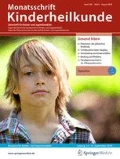Zusammenfassung
Die im vorliegenden Beitrag dargestellten 6 kindlichen Hüfterkrankungen wurden ausgewählt, weil sie entweder häufig sind, oder – nicht oder zu spät erkannt – zu einem das Leben bestimmenden Leiden werden können. Letzteres gilt besonders für die mit Frühestdiagnose und sofortiger Therapie meist gut zu beeinflussenden Krankheitsbilder der kongenitalen Hüftdysplasie, der Epiphyseolysis capitis femoris sowie der spastischen Hüftdezentrierung. Der M. Legg-Calvé-Perthes nimmt insofern eine Sonderstellung ein, als er auch den Erfahrenen vor größte differenzialtherapeutische Probleme stellen kann. Alltäglich in jeder pädiatrischen Praxis, jedoch letztendlich harmlos sind der hüftbedingte Innenrotationsgang des Kleinkindes sowie die Coxitis fugax, die jedoch vom M. Legg-Calvé-Perthes abgegrenzt werden muss.
Abstract
The 6 infantile hip diseases described in the present article were selected, because they are either common or may lead to lifelong disability when not diagnosed or diagnosed too late. This is especially the case regarding congenital dysplasia of the hip, slipped capital femoral epiphysis, and spastic hip dislocation. These diseases can generally be successfully treated, if they are diagnosed early and treated immediately. Legg-Calvé-Perthes disease occupies a special position, as it may also result in treatment difficulties even among experienced colleagues. Commonly seen, but in the end harmless, in daily pediatric practice are infantile intoeing gait and transient coxitis. The latter, however, has to be differentiated from Legg-Calvé-Perthes disease.






Literatur
Skuban TP, Vogel T, Baur-Melnyk A et al (2009) Function-orientated structural analysis of the proximal human femur. Cells Tissues Organs 190:247–255
Heimkes B, Martignoni K, Utzschneider S, Stotz S (2011) Soft tissue release of the spastic hip by psoas-rectus transfer and adductor tenotomy for long-term functional improvement and prevention of hip dislocation. J Pediatr Orthop B 20(4):212–221
Heimkes B, Komm M, Melcher C (2009) Die subtrochantäre End-zu-Seit-Valgisation zur Therapie der schweren kindlichen Coxa vara. Oper Orthop Traumatol 21(1):97–111
Kries R von, Ihme N, Oberle D et al (2003) Effect of ultrasound screening on the rate of first operative procedures for developmental hip dysplasia in Germany. Lancet 362:1883–1887
Graf R (2010) Sonographie der Säuglingshüfte und therapeutische Konsequenzen. Ein Kompendium. Thieme, Stuttgart New York
Tschauner C, Fürntrath F, Saba Y et al (2011) Developmental dysplasia of the hip: impact of sonographic newborn hip screening on the outcome of early treated decentered hip joints – a single center retrospective comparative cohort study based on Graf′s method of hip ultrasonography. J Child Orthop 5:415–424
Tschauner C, Klapsch W, Baumgartner A, Graf R (1994) „Reifungskurve“ des sonographischen Alpha-Winkels nach GRAF unbehandelter Hüftgelenke im ersten Lebensjahr. Z Orthop Ihre Grenzgeb 132:502–504
Thaler M, Biedermann R, Lair J et al (2011) Cost-effectiveness of universal ultrasound screening compared with clinical examination alone in the diagnosis and treatment of neonatal hip dysplasia in Austria. J Bone Joint Surg Br 93:1126–1130
Staheli LT, Corbett M, Wyss C, King H (1985) Lower-extremity rotational problems in children. J Bone Joint Surg Am 67-A(1):39–47
Jani L, Schwarzenbach U, Afifi K et al (1979) Verlauf der idiopathischen Coxa valga antetorta. Orthopade 8:5–11
Kocher MS, Zurakowski D, Kasser JR (1999) Differentiating between septic arthritis and transient synovitis of the hip in children: an evidence-based clinical prediction algorithm. J Bone Joint Surg Am 81:1662–1667
Nelitz M, Lippacher S, Krauspe R, Reichel H (2009) Morbus Perthes. Diagnostische und therapeutische Prinzipien. Dtsch Arztebl 106(31–32):517–523
Strobl W, Ganger R, Grill F (2004) Morbus Perthes. In: Wirth CJ, Zichner L (Hrsg) Orthopädie und orthopädische Chirurgie. Becken, Hüfte. Thieme, Stuttgart New York
Catterall T (1971) The natural history of Perthes′ disease. J Bone Joint Surg Br 1:37–53
Herring JA, Neustadt JB, Williams J et al (1992) The lateral pillar classification of Legg-Calvé-Perthes disease. J Pediatr Orthop 12:143–150
Meurer A, Schwitalle M, Humke T et al (1999) Vergleich der prognostischen Aussagefähigkeit der Catterall- und Herring-Klassifikation bei Patienten mit Morbus Perthes. Z Orthop Ihre Grenzgeb 137:168–172
Stulberg SD, Cooperman DR, Wallensten R (1981) The natural history of Legg-Calvé-Perthes disease. J Bone Joint Surg Am 63:1095–1108
Imhäuser G (1988) Die spontane Nekrose der koxalen Femurepiphyse in der Pubertätszeit. Z Orthop Ihre Grenzgeb 126:373–376
Wirth T (2011) Epiphyseolysis capitis femoris. Z Orthop Unfall 149(4):e21–e41
Velasco R, Schai PA, Exner GU (1998) Slipped capital femoral epiphysis: a long-term follow-up study after open reduction of the femoral head combined with subcapital wedge resection. J Pediatr Orhtop B 7(1):43–52
Robin J, Kerr Graham H, Selber P et al (2008) Proximal femoral geometry in cerebral palsy. J Bone Joint Surg Br 90-B:1372–1379
Reimers J (1980) The stability of the hip in children. A radiological study of the results of muscle surgery in cerebral palsy. Acta Orthop Scand Suppl 184:1–100
Interessenkonflikt
Der korrespondierende Autor gibt an, dass kein Interessenkonflikt besteht.
Author information
Authors and Affiliations
Corresponding author
Rights and permissions
About this article
Cite this article
Heimkes, B. Erkrankungen des kindlichen Hüftgelenks. Monatsschr Kinderheilkd 161, 355–368 (2013). https://doi.org/10.1007/s00112-013-2875-x
Published:
Issue Date:
DOI: https://doi.org/10.1007/s00112-013-2875-x
Schlüsselwörter
- Kongenitale Hüftdysplasie
- Einwärtsdrehgang
- M. Legg-Calvé-Perthes
- Epiphyseolysis capitis femoris
- Spastische Hüftluxation

